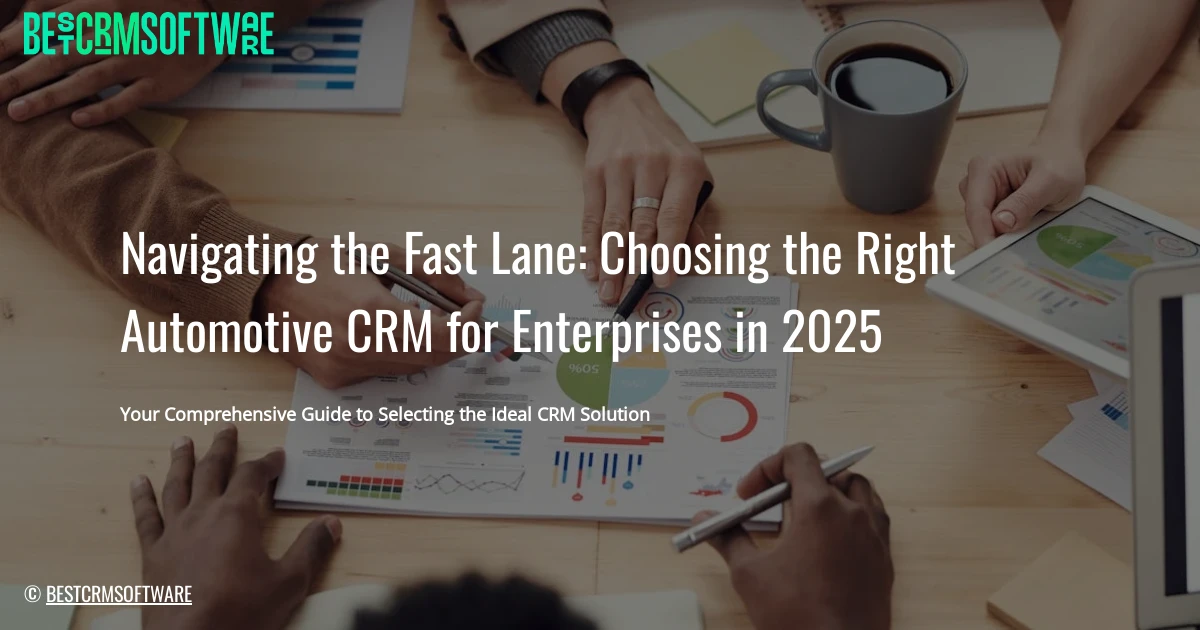Your Comprehensive Guide to Selecting the Ideal CRM Solution
Introduction: The Transformative Power of Automotive CRM in 2025
The automotive industry is undergoing a seismic shift. Consumers are no longer content with traditional car-buying experiences. They demand personalized, seamless interactions across every touchpoint, from online research to post-sale service. This evolution has sparked a revolution in customer relationship management (CRM), empowering businesses to navigate the fast lane and stay ahead of the competition.
The evolving landscape of customer expectations in the automotive industry. Today’s consumers are tech-savvy and digitally driven. They leverage online resources, compare multiple dealerships, and engage in extensive research before making a purchase. They expect personalized communication, transparent pricing, and frictionless experiences throughout their journey. Meeting these heightened expectations requires a comprehensive understanding of customer needs and desires, coupled with data-driven strategies that foster trust and loyalty.
Understanding the role of CRM in addressing modern challenges. Automotive CRM is not just a tool for managing contacts and scheduling appointments; it’s the driving force behind successful customer relationships. It empowers businesses to:
- Collect and analyze customer data to gain valuable insights into buying preferences, service needs, and satisfaction levels.
- Personalize communications and offers tailored to individual customer segments and behaviors.
- Optimize the customer journey across all touchpoints, streamlining processes and enhancing engagement.
- Improve service delivery and support through integrated communication channels and real-time information access.
Key features an enterprise-grade Automotive CRM should possess in 2025 and beyond. As the automotive industry continues to evolve, automotive CRM solutions must adapt to meet the needs of tomorrow. Key features to look for include:
- Advanced Analytics: Robust data analysis capabilities for extracting insights, predicting customer behavior, and driving informed decision-making.
- Omni-channel Integration: Seamless connection across online channels, social media, mobile apps, dealerships, and service departments, providing a unified customer experience.
- AI-powered Automation: Automation for tasks like lead scoring, personalized recommendations, and proactive service scheduling to optimize efficiency and personalization.
- Customer Journey Mapping: A comprehensive understanding of the customer lifecycle, enabling targeted interventions and enhancing customer satisfaction.
- Service & Aftersales Integration: Seamless integration with service departments, offering transparent information, scheduling tools, and customer feedback mechanisms.
This paper will explore the key aspects of choosing the right automotive CRM, empowering enterprises to unlock new levels of customer engagement and drive business growth in the fast-paced automotive landscape of 2025 and beyond.
Laying the Groundwork: Assessing Your Needs and Goals
Choosing the right Automotive CRM is a pivotal decision, and one that requires a thorough understanding of your needs and goals. In a market evolving at a breakneck pace, this process is crucial to ensuring long-term success.
Here’s how to lay the foundation for a smart CRM selection:
1. Identifying and segmenting your target audience in a rapidly changing market:
- Customer insights are paramount: Understand your customer segments, their buying habits, and their preferred communication channels. This may involve researching current trends, utilizing data analytics, and conducting surveys to gather real-time insights.
- Adaptability is key: The automotive industry is dynamic. Anticipate potential changes in consumer demographics, buying patterns, and technological preferences. Your CRM should be flexible and scalable to adapt to these changes seamlessly.
2. Defining your dealership or enterprise’s specific needs and pain points:
- Identify critical processes: Analyze your existing workflows and identify bottlenecks or areas where efficiency can be improved. Is lead management cumbersome? Are customer retention rates lagging? Do you struggle with data management?
- Consider departmental needs: Different departments within your enterprise will have specific requirements. For example, sales might prioritize lead nurturing features, while service could focus on customer service management tools.
3. Prioritizing features and integrations critical to your success:
- Define your non-negotiables: What are the essential features that a CRM must have to solve your specific problems? For instance, if marketing automation is a top priority, the CRM should offer powerful marketing features with robust integrations.
- Evaluate integrations: Modern CRMs integrate seamlessly with a range of other business applications. Identify the existing software you rely on (e.g., email marketing platforms, accounting systems) and prioritize CRMs that can integrate effectively to streamline workflows and data sharing.
By diligently addressing these points, you establish a clear understanding of your current needs and future goals, setting the stage for choosing an Automotive CRM that empowers you to navigate the fast lane of the evolving automotive market.

© Andrea Piacquadio
Harnessing the Power of Data: CDP Integration in Automotive CRM
The automotive industry is in constant motion, driven by technological advancements, evolving customer expectations, and a highly competitive landscape. To navigate this fast lane successfully, enterprises need a robust, data-driven strategy, and this is where Customer Data Platforms (CDPs) become indispensable.
Deep dive into Customer Data Platforms (CDPs) and their significance in 2025:
CDPs are emerging as the unifying force for customer data. Unlike traditional CRM systems focused solely on sales and marketing, CDPs aggregate and unify customer data from diverse sources, providing a single, comprehensive view of each customer across the entire customer journey. In 2025, this comprehensive view will be even more crucial as the automotive landscape becomes increasingly data-driven, demanding greater personalization and seamless experiences.
How CDPs empower hyper-personalized customer experiences in the automotive industry:
- Individualized communication: With a detailed understanding of customer preferences, behavior, and interactions, CDPs enable personalized marketing campaigns and targeted communications. Dealerships can send tailored offers, schedule maintenance reminders based on vehicle history, and recommend relevant upgrades or accessories based on individual driving habits.
- Seamless service: Imagine a scenario where a customer experiencing a vehicle issue can simply walk into a dealership and receive instant support based on their service history, previous interactions, and preferences. CDPs empower dealerships to deliver personalized, proactive, and efficient service experiences.
- Optimized product development: By analyzing customer feedback and data collected from connected vehicles, CDPs can provide insights into customer needs and pain points. This information can fuel the development of future models, technologies, and features, driving product innovation that caters precisely to customer desires.
Integrating your Automotive CRM with CDP for a 360-degree customer view:
While both CRM and CDP are valuable tools, their true potential is unleashed when they work in harmony. Integrating a CDP with your Automotive CRM creates a powerful synergy, enabling a holistic view of each customer across their journey:
- Unified customer profile: A CDP pulls data from your CRM system alongside other sources, such as dealership records, website analytics, social media activity, and even data from connected vehicles. This consolidated view provides a comprehensive understanding of customer needs, behaviors, and preferences.
- Data-driven insights: Integrating the two platforms enables advanced analytics and AI-driven insights, uncovering hidden patterns and trends that can guide your marketing, sales, and customer service strategies.
- Hyper-personalized engagement: By drawing from both CRM and CDP data, your communication becomes targeted and personalized. Whether it’s promoting specific vehicle upgrades based on individual driving habits or recommending personalized financing options based on credit history, the integration ensures highly relevant and engaging interactions.
In conclusion, the convergence of CDP and CRM will be instrumental in driving customer engagement, maximizing service excellence, and creating long-lasting customer loyalty in the fast-paced automotive industry of 2025.
Data-Driven Decisions: Unlocking the Value of Analytics and Reporting
In the fast-paced automotive landscape of 2025, data isn’t just valuable – it’s the key to survival. To truly navigate the fast lane, enterprises must embrace the power of analytics and reporting, using them to fuel strategic decisions and propel their businesses forward. Here’s how the right automotive CRM can unlock the potential of data:
1. Real-time Data Synchronization and Insights: Imagine a dashboard that seamlessly aggregates and presents data from all your touchpoints – sales, service, marketing, and even customer interactions – in real-time. An effective CRM does exactly this, creating a unified view of your customer journey and providing instant access to actionable insights. No more struggling with fragmented data silos or delayed reporting; instead, you’re equipped with real-time data for making informed decisions about everything from sales strategy to service scheduling.
2. AI-Powered Predictive Analytics for Enhanced Decision-Making: The era of data overload is upon us, but harnessing the power of AI within your CRM can turn this challenge into a powerful advantage. By analyzing patterns in your data, AI algorithms can anticipate customer behavior, predict sales trends, and identify potential risks. This predictive capability enables preemptive action – whether it’s launching targeted campaigns, optimizing inventory, or proactively addressing customer concerns.
3. Analyzing Sales Pipelines, Customer Behavior, and Market Trends Effectively: A robust CRM empowers you to delve deeper into the intricate details of your operations. Analyze the health of your sales pipeline to identify bottlenecks, understand the factors influencing customer behavior across different demographics, and gain insights into emerging market trends. By utilizing dashboards, custom reports, and interactive data visualizations, you can pinpoint key performance indicators, measure the success of your initiatives, and make strategic adjustments as needed.
The Future is Data-Driven
In 2025, the ability to harness and leverage data will separate the winners from the also-rans in the automotive industry. A sophisticated CRM with robust analytics capabilities is not simply a tool – it’s a strategic asset that can provide you with the insights necessary to drive growth, enhance customer satisfaction, and maintain your competitive edge.

© LinkedIn Sales Navigator
Revolutionizing Sales and Marketing: From Leads to Loyal Customers
The automotive industry in 2025 will be driven by a seamless, data-driven approach. Automotive CRMs are becoming crucial to success, enabling dealerships to transform their sales and marketing strategies from lead generation to customer loyalty. Here’s how:
1. Streamlining the Sales Process through Automated Lead Nurturing and Follow-ups:
Modern automotive CRMs automate tedious tasks, allowing sales teams to focus on what they do best: building relationships. Imagine this: a customer inquiries about a specific model online, triggering automated email sequences providing relevant information and exclusive offers. The CRM automatically schedules follow-up calls, ensuring no lead falls through the cracks. This personalized approach not only reduces manual effort but also nurtur[es relationships leading to increased conversion rates.
2. Utilizing CRM for Efficient Inventory Management and Vehicle Lifecycle Tracking:
Keeping track of vehicles in stock, their maintenance history, and even their projected future value becomes effortless with advanced CRM capabilities. Dealerships gain valuable insights into demand patterns, vehicle turnover rates, and customer preferences, allowing them to optimize inventory management and pricing strategies. The ability to track a vehicle’s entire lifecycle, from initial sale to trade-in, ensures efficient logistics and informed decision-making.
3. Optimizing Sales Team Performance and Improving Lead Conversion Rates:
CRM data analytics offer dealerships real-time insights into sales team performance. Identify top-performing salespeople, uncover areas for improvement, and tailor training programs accordingly. The insights gained through CRM data can predict customer behaviour, enabling targeted marketing campaigns and personalized interactions that ultimately drive higher conversion rates.
By leveraging these powerful features, automotive CRMs allow dealerships to not just sell cars but build lasting relationships with customers, transforming them from fleeting leads into loyal brand ambassadors. The journey towards efficient and profitable sales in 2025 starts with choosing the right automotive CRM that can pave the way to a bright future.
Beyond Sales: Fostering Customer Loyalty and Retention
In the competitive landscape of the automotive industry, capturing customer interest is only half the battle. Building lasting relationships that translate into repeat business and enthusiastic referrals requires more than just a smooth sales process. That’s where a powerful CRM system steps in, empowering you to transcend transactional interactions and cultivate true loyalty.
Here’s how the right Automotive CRM can help you:
1. Creating exceptional customer experiences through personalized communications:
A modern Automotive CRM goes beyond basic data storage. It empowers you to delve into individual customer preferences, purchase history, and service needs, allowing you to tailor your communications for maximum impact. Imagine sending targeted email campaigns promoting specific features relevant to a customer’s past purchases or offering personalized service reminders based on their vehicle’s maintenance schedule. Such personalized interactions elevate the customer experience, making them feel valued and understood.
2. Managing and responding to customer inquiries and feedback effectively:
The automotive industry is inherently customer-centric. Promptly addressing queries and feedback, both positive and negative, is crucial for maintaining trust and building loyalty. An Automotive CRM with integrated customer support tools enables you to track inquiries, manage communication channels effectively, and offer prompt and helpful responses, all while capturing valuable customer feedback for continuous improvement.
3. Building brand loyalty through personalized offers, service reminders, and rewards programs:
Keeping customers engaged after the sale is key to fostering long-term loyalty. A CRM system can become your go-to tool for nurturing relationships. Automate personalized offers based on customer needs and preferences, send timely service reminders to encourage regular maintenance, and implement tailored rewards programs for frequent buyers or loyal customers. By continuously engaging with your customer base in meaningful ways, you create lasting loyalty and encourage word-of-mouth marketing.
In short, the right Automotive CRM empowers you to move beyond the transactional and embrace a holistic approach to customer engagement. It provides the tools to understand your customer base, anticipate their needs, and nurture relationships that translate into lasting loyalty and a thriving automotive enterprise.

© Pixabay
Meeting Customers on the Go: The Importance of Mobile CRM
The automotive landscape is changing at an unprecedented pace. As consumers increasingly rely on mobile devices for everything from research to purchase, understanding the growing significance of mobile-first customer interactions is paramount. This shift requires dealerships to adopt Automotive CRMs with robust mobile apps for seamless access.
Imagine this: a potential customer walks onto your lot, smartphone in hand, already equipped with research about your inventory. A well-equipped sales consultant armed with a mobile CRM app can seamlessly access this customer’s information, personalize their experience, and close the deal quickly and efficiently. This seamless interaction, fueled by a powerful mobile CRM, turns your sales staff into dynamic and informed representatives.
This isn’t just about customer experience; it’s also about empowering your sales and service teams with mobile CRM capabilities. A mobile-friendly CRM provides:
- Real-time access to customer data: From contact information and past service records to purchase history and preferences, crucial insights are at their fingertips.
- Instantaneous communication tools: Text, email, and even video call options enable personalized interactions throughout the customer journey, streamlining service inquiries, appointment scheduling, and even follow-up reminders.
- Efficient workflow management: Track leads, manage appointments, and close deals, all while on the move, enabling teams to stay organized and productive, regardless of location.
Investing in a mobile-first automotive CRM is not just a strategic advantage in 2025, it’s an absolute necessity. This ensures your team is always in sync with your customers, wherever they are, empowering a more efficient and satisfying customer experience.
The Cloud or On-Premise: Choosing the Right Deployment Model
As your enterprise navigates the ever-accelerating automotive landscape, choosing the right CRM deployment model becomes a crucial decision. You’re faced with three primary options: on-premise, cloud-based, or a hybrid approach. This section will help you understand the advantages and considerations of each model, empowering you to select the optimal strategy for your unique business requirements.
On-premise Deployment:
Advantages:
- Control and Security: You maintain complete ownership of the CRM system and all associated data. This provides unparalleled control over security protocols, access rights, and data storage.
- Customization: You have the flexibility to tailor the system to your exact specifications and workflows, often with greater customizability than cloud-based options.
- Data Residency: For organizations with stringent data residency requirements, keeping your data within your own physical infrastructure might be essential.
Considerations:
- Initial Investment: On-premise deployment requires significant upfront capital expenditure for hardware, software licensing, and installation.
- Ongoing Maintenance: You are responsible for all maintenance, updates, security patching, and infrastructure upgrades, which can be costly and time-consuming.
- Scalability: Expanding your CRM system can require substantial resource investment as you’ll need to purchase additional hardware and upgrade infrastructure to accommodate increased user load.
Cloud-Based Deployment:
Advantages:
- Lower Cost: Significant reduction in initial investment as you pay a subscription fee rather than large upfront capital expenditure.
- Scalability: Seamlessly scale up or down your CRM resources based on your fluctuating demands without substantial hardware investment.
- Ease of Deployment and Updates: Fast deployment with no complex infrastructure configuration and automatic updates ensure you’re always running the latest version.
- Accessibility: Access the CRM system from anywhere with an internet connection, making it convenient for remote teams and geographically diverse operations.
Considerations:
- Limited Customization: Customization options may be limited compared to on-premise systems.
- Security and Data Ownership: Data security and ownership become less tangible with third-party cloud providers, requiring careful vendor due diligence and thorough understanding of service agreements.
- Data Privacy Regulations: Comply with specific data residency regulations and security protocols in your region, which might be impacted by the provider’s geographic location and data practices.
Hybrid Deployment:
Advantages:
- Best of Both Worlds: This model leverages the strengths of both cloud and on-premise approaches. You can manage sensitive data on-premise while utilizing cloud solutions for scalability, accessibility, and specific CRM features.
- Flexible and Tailored: Allows for a customized approach based on the specific requirements of your different departments and business processes.
Considerations:
- Complexity: Requires careful planning, implementation, and ongoing management to ensure seamless integration and data flow between on-premise and cloud components.
- Potential Costs: Managing a hybrid model can increase administrative overhead and potential maintenance costs compared to a single-deployment option.
Ultimately, the right CRM deployment model for your automotive enterprise depends on your specific needs, priorities, and resources. Consider your data sensitivity, IT expertise, budgetary constraints, scalability requirements, and desired level of customization when making your decision. By carefully evaluating the advantages and considerations of each option, you can confidently select the deployment model that positions your enterprise for success in the fast lane.

© Pixabay
Building a Connected Ecosystem: Integrating with Your Automotive Tech Stack
In the fast-paced automotive industry, success hinges on leveraging a connected ecosystem where data flows freely and insights are readily accessible. An automotive CRM alone cannot achieve this – it needs to seamlessly integrate with your existing technology stack. Here’s where the true value of an effective CRM emerges:
- Ensuring seamless data flow between different dealership systems. Data residing in separate systems – from inventory management and service scheduling to marketing automation and customer relationship management – creates inefficiencies and limits your understanding of customer behavior. The right CRM acts as a central hub, pulling in data from various sources, eliminating data duplication, and creating a single source of truth.
- Integrating with popular automotive software solutions and third-party apps. Your dealership likely uses various software for finance, service, and parts operations. A successful CRM integrates seamlessly with these applications, sharing vital information, simplifying workflow, and eliminating manual data entry. This integration extends beyond your internal systems; the CRM should also connect to third-party apps like online review platforms, social media management tools, and marketing automation platforms, further enriching your customer data and maximizing marketing efforts.
- Breaking down data silos and maximizing the value of your technology stack. The true power of an automotive CRM lies in its ability to leverage data from across your entire tech ecosystem. By pulling insights from finance, service, marketing, and customer data, you can develop a holistic view of your customer journey. This consolidated data fuels targeted marketing campaigns, personalized customer experiences, and optimized service offerings – ultimately boosting sales and customer loyalty.
A connected ecosystem allows you to optimize efficiency, gain deeper insights, and tailor your service offerings, giving you a clear competitive edge. When selecting your automotive CRM, prioritizing seamless integration with your current technology stack is critical for unlocking its full potential.
Driving Efficiency with Automation: Work Smarter, Not Harder
In the relentless race to stay ahead in the automotive industry, efficiency is king. 2025 will demand an agile approach to customer relationship management (CRM), and that’s where automation steps onto the racetrack.
The crucial role of automation in streamlining CRM processes and workflows lies at the heart of a successful strategy. Imagine the power of freeing up your team from tedious, repetitive tasks to focus on building genuine connections with customers. This is the promise of a powerful, automated CRM.
Automating repetitive tasks like lead assignment, data entry, and reporting transforms your CRM from a cumbersome tool to a seamless, efficient powerhouse.
Imagine the impact:
- Lead assignment becomes instantaneous: Automated lead distribution ensures the right prospect lands with the right salesperson, instantly, no manual routing required.
- Data entry is effortless: Forget about manual data entry errors! Automated data capture streamlines data flow, ensuring accuracy and eliminating time-consuming checks.
- Reports generate automatically: Gain valuable insights into performance and customer behaviour without spending hours crunching numbers.
This frees up valuable time for your team to focus on high-value customer interactions. With the grunt work handled by automation, your sales team can nurture relationships, build trust, and deliver personalized experiences that drive conversion.
In the fast lane, every second counts. An automated automotive CRM ensures you’re not just going faster, you’re going smarter.

© fauxels
Elevating Customer Service with AI: Chatbots and Virtual Assistants
In the hyper-competitive automotive landscape of 2025, customer service is no longer a nice-to-have, it’s a necessity. To thrive, dealerships must leverage the power of AI to elevate customer interactions and build lasting relationships. This is where AI-powered chatbots and virtual assistants emerge as game-changers, offering numerous advantages:
- Instant Support, 24/7: Imagine a world where customers get answers to their questions in real-time, regardless of the time of day or their location. This is the promise of chatbots, acting as a tireless and efficient front-line agent. They can handle everything from simple inquiries about vehicle availability and pricing to more complex questions about service appointments.
- Qualifying Leads Effortlessly: Time is money, and every minute spent on non-qualified leads is a missed opportunity. Chatbots can quickly assess potential customers, asking relevant questions to gauge their level of interest and purchase intent. This allows sales teams to focus their efforts on genuinely interested buyers, boosting efficiency and closing more deals.
- A Seamless & Personalized Experience: Forget the days of generic, cookie-cutter interactions. AI chatbots can learn and adapt, understanding individual preferences and offering personalized recommendations based on past interactions. This allows them to provide tailored support and guidance, creating a seamless and engaging customer journey that fosters loyalty and trust.
By embracing AI-powered chatbots and virtual assistants, automotive dealerships in 2025 can dramatically improve customer satisfaction, reduce operating costs, and gain a competitive edge in the ever-evolving digital landscape.
Research and Comparison: Choosing the Best Automotive CRM Provider
Navigating the crowded automotive CRM landscape requires meticulous research and a keen eye for detail. Selecting the ideal CRM for your enterprise demands a multi-faceted approach, focusing on a few key steps:
1. Identifying Leading Automotive CRM Providers:
Don’t get bogged down in an overwhelming number of choices. Start by focusing on providers known for specializing in automotive solutions. Here, industry-specific features and an understanding of the nuances of automotive sales and service are crucial. Research firms like Gartner, Forrester, or other reputable tech review sites to uncover the top players in the automotive CRM space.
2. Comparing and Contrasting Features, Pricing Models, and Customer Support:
Once you have a list of potential contenders, it’s time to delve deeper into their offerings. This is where creating a clear set of criteria for evaluation becomes critical.
Consider factors such as:
- Feature Set: Evaluate the functionality essential for your needs – customer relationship management, sales force automation, marketing automation, service management, parts management, inventory management, dealership management, customer communication channels, data analytics, reporting, and integrations with third-party applications.
- Pricing Models: Examine different subscription plans and pricing tiers, considering potential scaling requirements as your enterprise grows. Pay close attention to potential hidden costs, such as training or implementation fees.
- Customer Support: Reliable customer support is vital for minimizing downtime and maximizing the CRM’s value. Assess the quality, responsiveness, and accessibility of available support channels, such as phone, email, chat, and knowledge base.
3. Reading Reviews and Case Studies:
No better resource exists than real-world user feedback. Online reviews, industry forums, and customer testimonials provide valuable insights into the practical experience of using different CRM systems. Additionally, researching case studies from other automotive enterprises that have successfully implemented CRM solutions can offer valuable lessons and practical guidance.
Pro Tip:
Reach out to potential CRM providers directly for demos and personalized presentations. This allows you to interact with the software, ask questions about specific features, and assess the company’s communication and responsiveness. By taking these steps, you’ll be well-positioned to identify the automotive CRM solution that best aligns with your enterprise’s specific requirements and ensures you’re cruising down the fast lane towards success in 2025.

© Vlada Karpovich
Calculating Your ROI: Demonstrating the Value of Automotive CRM
Choosing the right Automotive CRM is a strategic investment, not just a technological upgrade. To ensure maximum value from your CRM implementation, it’s critical to understand the key factors driving your return on investment (ROI) and to develop strategies for quantifying and demonstrating its impact.
Here’s how to measure and showcase the value of your CRM investment:
Factors to Consider When Determining ROI:
- Customer Acquisition Costs: Does your CRM system help you acquire new customers more efficiently, through targeted marketing and lead nurturing strategies?
- Sales Cycle Length: Can the CRM platform streamline your sales process and reduce the time it takes to close deals?
- Customer Retention Rates: How does your CRM contribute to improved customer satisfaction and loyalty, leading to increased retention?
- Operational Costs: Is your CRM solution helping you optimize internal processes, reducing operational overhead and improving overall efficiency?
- Employee Productivity: Does your CRM enable your sales team to be more productive and effective in their interactions with customers?
Quantifying the Impact of CRM on Sales, Customer Retention, and Operational Costs:
- Track and analyze sales pipeline metrics: Identify and measure key metrics such as lead generation, lead conversion rates, average deal size, and sales cycle length. Monitor changes in these metrics over time to assess the positive impact of CRM implementation.
- Calculate customer lifetime value (CLTV): Measure the revenue you generate from each customer over their lifetime with your business. Evaluate how CRM adoption improves customer engagement and loyalty, leading to a higher CLTV.
- Evaluate employee performance: Track key performance indicators (KPIs) such as sales quota attainment, customer satisfaction ratings, and number of closed deals. Demonstrate the correlation between CRM usage and improved employee performance.
- Measure operational cost savings: Calculate the impact of your CRM system on reducing administrative overhead, such as email marketing costs, call center expenses, and customer support resources.
Measuring Success and Demonstrating the Value of Your CRM Investment:
- Establish clear goals and key performance indicators (KPIs): Define specific goals for your CRM implementation, aligning with overall business objectives. Monitor and measure these KPIs regularly to track progress and measure ROI.
- Regular reporting and dashboards: Generate comprehensive reports and dashboards that highlight key CRM performance metrics, illustrating the tangible value of your investment to stakeholders.
- Create case studies and success stories: Highlight specific examples of how CRM implementation has resulted in improved sales, customer retention, and operational efficiencies. Use these stories to showcase the benefits of your CRM investment to others.
- Demonstrate tangible business outcomes: Don’t just rely on internal data – connect CRM improvements to real-world business outcomes, such as increased market share, improved customer satisfaction, or greater profitability.
By taking a data-driven approach and proactively tracking and measuring the impact of your CRM implementation, you can demonstrate the significant value of your investment to key stakeholders and pave the way for long-term success in the fast-paced automotive industry.
Data Security and Compliance: Safeguarding Your Most Valuable Asset
In the fast-paced world of automotive CRM, data is your fuel. It powers your marketing campaigns, fuels your sales efforts, and drives customer satisfaction. But like any valuable resource, it must be protected. In 2025, as regulations tighten and cyber threats escalate, data security and compliance become paramount concerns for automotive enterprises choosing an CRM.
Addressing Data Security Concerns and Choosing a CRM with Robust Security Measures:
Your automotive CRM must be built with security at its core. This means seeking solutions that offer:
- Data Encryption: Ensure all data stored, transmitted, and processed is encrypted, making it unreadable to unauthorized individuals.
- Multi-factor Authentication: Implement robust authentication mechanisms to prevent unauthorized access to your data.
- Access Control and Role-based Permissions: Grant access based on roles and specific user needs, limiting potential breaches.
- Regular Security Audits and Vulnerability Scanning: Continuously monitor for vulnerabilities and address them promptly, ensuring ongoing protection.
Ensuring Compliance with Relevant Data Privacy Regulations, such as GDPR and CCPA:
Navigating the global landscape of data privacy regulations is crucial. Choose an automotive CRM that offers features like:
- Data Minimization: Only collect and store data that is necessary for your business operations, respecting privacy principles.
- Consent Management: Ensure you have valid consent for collecting, processing, and sharing customer data, compliant with various regulations.
- Data Erasure: Implement features allowing you to easily erase customer data upon request, as per regulations like the Right to be Forgotten.
Protecting Sensitive Customer Information and Maintaining Data Integrity:
The data you collect and manage through your CRM is extremely sensitive, often containing personal information. Therefore, your CRM must:
- Data Masking and Redaction: Implement techniques that allow you to securely anonymize or redact sensitive information, minimizing risks during internal and external use.
- Secure Data Backup and Recovery: Regular backups and robust disaster recovery plans ensure the preservation and accessibility of your critical customer data, even in case of incidents.
By prioritising these aspects, automotive enterprises can choose a CRM that effectively safeguards their valuable customer data, fostering trust and securing a sustainable competitive advantage in the years to come.

© Tranmautritam
Implementing Your Automotive CRM: Planning for a Smooth Transition
Successfully implementing a new Automotive CRM system requires careful planning and execution. It’s not just about the software; it’s about aligning your entire organization around the new system and maximizing its potential. Here’s how to navigate the transition smoothly:
Understanding the implementation process and potential challenges:
- Data migration: This is often a complex and time-consuming step. Ensuring the accurate and complete migration of existing customer, sales, and service data is crucial for leveraging the CRM effectively.
- User adoption: Encouraging and facilitating user adoption is key to realizing the CRM’s full value. Resistance from employees can hinder its effectiveness, so a well-structured training program is crucial.
- Customization and integration: Tailoring the CRM to your specific needs and seamlessly integrating it with your existing systems, like inventory management or finance, can be challenging but ultimately essential.
- Ongoing support: Access to reliable support resources, including technical assistance and dedicated account management, is essential for troubleshooting issues and maximizing the value of the chosen platform.
Preparing your team for the transition and providing adequate training:
- Identify key stakeholders: Engage your key players early, from leadership to frontline staff, in the planning and implementation process. This ensures everyone understands the goals, potential benefits, and their role in achieving a successful launch.
- Develop a training strategy: Design comprehensive training programs that address both the technical aspects of using the CRM and its specific functionalities within your automotive processes (e.g., lead generation, sales follow-up, customer service).
- Communicate openly: Regular and transparent communication about the upcoming transition, training, and expected benefits helps build buy-in and minimize apprehension amongst staff.
Developing a clear implementation plan and setting realistic expectations:
- Establish clear goals and metrics: Define measurable objectives for the implementation, including KPIs like increased sales, enhanced customer satisfaction, and improved efficiency. Track these metrics to gauge progress and make necessary adjustments.
- Set a realistic timeline: Break down the implementation into manageable phases, accounting for potential challenges and setbacks. This provides structure and visibility for both the implementation team and your stakeholders.
- Phase in the system gradually: Instead of a sudden switch, consider piloting the CRM with a specific team or department to gather feedback and refine processes before broader adoption.
- Plan for continuous improvement: Implementing a new CRM is not a one-time event. Continuously monitor its effectiveness, solicit user feedback, and make necessary adjustments to ensure its long-term success.
By thoughtfully planning, actively managing the transition, and effectively communicating with your team, you can smoothly implement your automotive CRM and position your organization for future growth and success.
Support and Maintenance: Ensuring Long-Term Success
Investing in a powerful Automotive CRM is only the first step towards driving success. The long-term journey involves navigating the complexities of implementation and ensuring the system consistently delivers value. This is where the importance of robust support and maintenance becomes paramount.
Choosing a CRM provider that offers ongoing support and resources is crucial for ensuring smooth operations and maximizing your CRM’s potential. Look for providers who offer comprehensive support options including:
- Dedicated account managers: A personal point of contact for assistance, troubleshooting, and strategic guidance.
- 24/7 customer service: Quick responses to urgent issues, especially during peak business hours.
- Knowledge base and training materials: Accessible resources for self-service support, onboarding new users, and optimizing system usage.
- Regular updates and enhancements: Continuously improving functionality and security with software updates and feature additions.
- Data migration services: Seamless integration of existing customer data and business processes.
Leveraging these resources can significantly enhance your CRM journey. Utilizing training materials will help you fully understand the system’s functionalities, empowering you to optimize its usage for your specific business needs. Engaging with online forums fosters collaboration and allows you to connect with other users, exchanging knowledge and insights. By taking advantage of the resources provided, you can streamline operations, overcome obstacles, and maximize your CRM investment.
Ultimately, ensuring the long-term success of your CRM implementation relies heavily on proper support. By choosing a provider committed to offering comprehensive and dedicated assistance, you create a foundation for ongoing growth and continuous improvement. This fosters an environment where you can leverage your CRM effectively, maximize its potential, and confidently navigate the fast lane of automotive success in 2025.

© Tim Gouw
Future Trends in Automotive CRM: Beyond 2025
The automotive industry is on the cusp of a transformative era, driven by rapid technological advancements, changing consumer preferences, and a growing emphasis on sustainability. Navigating this dynamic landscape necessitates a future-proof CRM strategy that goes beyond traditional functionalities. This means embracing the evolving trends that are set to define the automotive customer experience in 2025 and beyond.
Exploring future trends shaping the automotive industry and CRM:
- Hyper-personalization: The era of cookie-cutter marketing is fading. Expect a surge in personalized experiences, fueled by AI-driven data analytics. CRMs will leverage consumer insights, purchase history, and behavioral patterns to offer tailored recommendations, promotions, and even service appointments.
- Omnichannel Integration: The customer journey is no longer linear. Expect a seamless omnichannel experience across digital platforms, mobile applications, dealerships, and even connected vehicles. This will require CRMs that bridge the gap between online and offline interactions.
- Sustainable Solutions: Sustainability is gaining significant traction in the automotive sector. Consumers are increasingly interested in environmentally-friendly options, driving the demand for electric vehicles and eco-conscious dealerships. CRMs will need to adapt to these demands, integrating information about sustainable offerings and customer preferences.
- AI-driven Service and Support: Automation is revolutionizing customer service. AI chatbots, predictive maintenance systems, and personalized support tools are becoming indispensable. CRMs will leverage these technologies to deliver efficient, proactive, and personalized assistance throughout the entire customer lifecycle.
Adapting to emerging technologies like augmented reality (AR) and virtual reality (VR):
- AR/VR in Sales and Service: Immersive technologies like AR and VR are poised to redefine the car buying experience. AR-powered showroom tools can allow customers to visualize vehicles in their preferred configurations. Virtual reality can offer immersive test drive experiences and offer 360-degree views of the car’s interior and exterior. CRMs will need to integrate seamlessly with these technologies, delivering an engaging and interactive customer journey.
- Personalized Automotive Experiences: AR and VR will extend beyond dealerships and showroom settings. Imagine using an AR app to scan a damaged part and receive instant diagnostics and repair recommendations. Or using VR to visualize personalized modifications before making a purchase. These possibilities highlight the future potential of integrating AR/VR into CRM systems to enhance customer engagement.
Staying ahead of the curve and preparing for the future of customer experience:
- Embrace Agility and Innovation: The automotive industry is fast-paced and unpredictable. To thrive in 2025 and beyond, enterprises must prioritize flexibility and be ready to adopt new technologies and strategies as they emerge.
- Data-Driven Decision Making: The key to staying ahead of the curve lies in leveraging data. Effective CRMs will collect, analyze, and act on insights to personalize experiences, optimize sales strategies, and tailor services to meet evolving customer demands.
- Focus on Customer Relationships: In the future, the focus will shift from transactional sales to building lasting customer relationships. CRM solutions that nurture these relationships, fostering brand loyalty and advocacy, will be essential for long-term success.
In conclusion, embracing these emerging trends is crucial for automotive businesses seeking to thrive in the fast-paced, technologically driven future. Choosing the right automotive CRM system today will lay the foundation for an exceptional customer experience that aligns with future needs and prepares for a dynamic and evolving industry.
The Future is Now: Embrace Automotive CRM for Sustainable Growth
The automotive industry is evolving at a breakneck pace, driven by digitalization, customer-centricity, and a relentless focus on innovation. To navigate this fast lane successfully, enterprises need a strategic edge – and that edge is Automotive CRM.
Highlighting the Competitive Edge of Leveraging Automotive CRM in the Industry:
Automotive CRM isn’t just another tool; it’s a powerful engine for sustainable growth. By centralizing and organizing customer data, CRM systems empower businesses to:
- Understand the Customer Journey: From initial research to after-sales service, Automotive CRM allows a holistic view of customer interactions. This deep understanding enables personalized experiences, targeted campaigns, and ultimately, higher customer satisfaction.
- Drive Sales and Enhance Revenue: CRM systems track customer engagement and nurture leads, optimizing sales processes and maximizing conversion rates. Data-driven insights reveal buying patterns and market trends, fueling more effective sales strategies.
- Improve Operational Efficiency: Streamlining processes, from lead management and inventory control to service scheduling and customer communication, saves time, resources, and costs. Automations further boost efficiency, freeing up teams to focus on high-value tasks.
- Strengthen Customer Loyalty: Building strong relationships is key to long-term success. CRM enables personalized communication, targeted offers, and seamless service experiences that foster customer loyalty and advocate referrals.
Showcasing Success Stories and Real-World Examples of CRM Implementation:
- [Company X]: This leading car manufacturer leveraged CRM to unify their fragmented data, personalize customer interactions across channels, and improve the overall customer experience. This resulted in a significant increase in customer satisfaction, retention, and sales.
- [Company Y]: By implementing CRM, this dealership group streamlined their sales and service processes, achieving improved efficiency, increased staff productivity, and enhanced customer loyalty. The results included a measurable increase in repeat business and a reduction in service turnaround times.
Reinforcing the Importance of Staying Ahead of the Technology Curve:
Automotive CRM isn’t static; it constantly evolves to meet changing customer needs and market trends. The future of Automotive CRM lies in:
- Advanced Analytics and AI: Predictive modeling, real-time insights, and AI-powered automation offer even greater efficiency and customer personalization.
- Seamless Integration: CRM must integrate seamlessly with other crucial business systems, such as dealer management systems, service scheduling software, and marketing platforms, to ensure a comprehensive customer view.
- Mobile and Omnichannel Focus: Providing exceptional customer experiences across multiple touchpoints, from websites and apps to chatbots and social media, is key.
The future of the automotive industry is driven by technology and customer-centricity. Embracing Automotive CRM today is not just about staying ahead of the curve; it’s about securing a competitive edge for sustainable growth in the years to come.

© Lukas
Frequently Asked Questions (FAQs) About Automotive CRM
As you navigate the world of automotive CRM systems, you’re bound to have questions. We’ve compiled a list of frequently asked questions to address your concerns and provide clarity on key aspects of automotive CRM.
1. What is Automotive CRM and Why Do I Need It?
Automotive CRM stands for Customer Relationship Management for the automotive industry. It’s a powerful suite of tools designed specifically for dealerships and manufacturers to manage customer interactions, optimize sales processes, and improve customer satisfaction. You need it because:
- Improved Customer Experience: Automotive CRM empowers you to understand customer needs better, providing personalized communication and seamless experiences.
- Increased Sales Efficiency: Automated tasks, data-driven insights, and streamlined workflows lead to faster and more successful sales cycles.
- Enhanced Loyalty: Building strong relationships with customers leads to increased repeat business and positive word-of-mouth referrals.
- Data-Driven Decision-Making: Robust reporting and analytics capabilities offer valuable insights for informed strategic decision making.
2. How Can Automotive CRM Benefit My Dealership?
An automotive CRM offers numerous benefits for dealerships:
- Lead Generation and Management: Effectively track, manage, and qualify leads from various sources, ensuring no potential customer is missed.
- Personalized Communication: Engage customers with targeted email campaigns, SMS messages, and personalized offers tailored to their specific interests and needs.
- Service Appointment Scheduling: Streamline scheduling for service appointments, reducing cancellations and improving customer satisfaction.
- Inventory Management: Track inventory levels, monitor vehicle movements, and receive alerts when low-demand models require attention.
- Improved Customer Service: Efficiently resolve customer issues and manage requests, fostering strong customer relationships and encouraging loyalty.
3. What are the Key Features of an Automotive CRM?
Essential features of an automotive CRM system include:
- Lead Management: Track, qualify, and nurture leads across various channels.
- Sales Automation: Automate repetitive tasks like appointment scheduling, email marketing, and follow-up communication.
- Customer Service and Support: Manage inquiries, complaints, and support requests efficiently.
- Marketing Automation: Utilize personalized campaigns and segmentation for targeted marketing efforts.
- Inventory Management: Monitor stock levels, track vehicle movement, and optimize inventory distribution.
- Reporting and Analytics: Gain valuable insights into sales performance, customer behavior, and other key metrics.
- Integration with Existing Systems: Integrate seamlessly with your dealership’s existing software like DMS and accounting systems.
4. How Much Does an Automotive CRM Cost?
The cost of an automotive CRM system varies depending on the features, functionality, and provider. Most providers offer different subscription packages to fit various dealership sizes and needs. It’s important to research different options and compare pricing based on your specific requirements.
5. What About Security and Data Privacy?
Security and data privacy are paramount in choosing a CRM. Look for systems with robust data encryption, secure login credentials, and compliance with relevant regulations such as GDPR and CCPA. Ensure the provider has a comprehensive security policy and demonstrates commitment to protecting customer information.
6. What if I’m Not Tech-Savvy?
Most reputable CRM vendors offer training resources and support to ensure smooth implementation and use of their system. Choose a solution with an intuitive interface, excellent customer support, and readily available online help documentation.
7. Is it Worth the Investment?
Investing in an automotive CRM offers significant return on investment. By optimizing processes, improving efficiency, and enhancing customer relationships, you’ll gain a competitive edge in today’s fast-paced automotive market.
Ready to Take the First Step?
We understand your need for clear answers. Contact us to discuss your specific requirements, receive a personalized demo, and make an informed decision about the right automotive CRM for your dealership’s success in 2025 and beyond.
Conclusion: Embracing the Future of Automotive Customer Experience
Navigating the Fast Lane: Choosing the Right Automotive CRM for Enterprises in 2025 is more than just an article; it’s a roadmap to revolutionize the automotive industry’s relationship with customers. This article unveils the essential elements for success in the modern automotive landscape, where personalization, data-driven insights, and seamless customer journeys are the new benchmarks.
Here’s a recap of our key takeaways and insights:
- Customer expectations are rapidly evolving. Auto buyers in 2025 crave a personalized experience across every touchpoint, from initial online research to post-purchase support.
- The right Automotive CRM is paramount. It acts as a centralized hub, providing a comprehensive view of each customer, streamlining processes, and empowering sales, service, and marketing teams with the tools needed to build stronger customer relationships.
- Beyond basic CRM functionalities, look for AI-powered insights, seamless integration with existing systems, and mobile-first design. These features drive data-driven decision-making, automate tasks, and provide a user-friendly interface accessible anytime, anywhere.
Moving forward, here’s a path to implementation success:
- Clearly define your needs and goals. Identify specific challenges you face and how an Automotive CRM can help overcome them.
- Conduct a thorough vendor evaluation. Research the market and choose a CRM platform that aligns with your current business processes, scalability needs, and budget.
- Invest in training and support. Ensure your team is well-versed in the chosen CRM system and can leverage its capabilities effectively.
- Continuously monitor and refine. Track your CRM implementation’s impact on customer engagement, sales, and service operations, and adapt as necessary.
The transformative power of Automotive CRM is undeniable. It enables automotive enterprises to:
- Boost customer satisfaction through personalized experiences, prompt communication, and tailored offers.
- Drive revenue growth by leveraging data insights for strategic campaigns and optimizing sales processes.
- Strengthen customer loyalty by building strong connections based on understanding individual needs and preferences.
- Improve operational efficiency by automating workflows, reducing errors, and gaining a centralized view of customer interactions.
As the automotive landscape continues to evolve at breakneck speed, investing in the right Automotive CRM is not just a smart move, it’s a necessity. Embrace the power of technology to shape the future of your business and deliver truly exceptional customer experiences in the Fast Lane of innovation.

© Buro Millennial
Resources
GLOBAL AUTOMOTIVE CUSTOMER RELATIONSHIP MANAGEMENT MARKET …
BEST AUTOMOTIVE CRM SOFTWARE COMPARISON & REVIEWS 2024 – PAGE 3
BENEFITS AUTOMOTIVE CRM FOR TODAY’S DIGITAL DEALERSHIP
POLK AUTOMOTIVE SOLUTIONS – S&P GLOBAL
TOP 5 CRM ENTERPRISE SOFTWARE [COMPARATIVE GUIDE]
5 CLOUD BASED SOFTWARES FOR YOUR CONSTRUCTION BUSINESS – YOUTUBE

